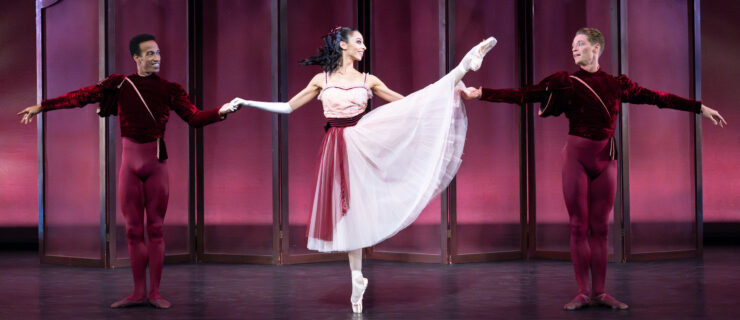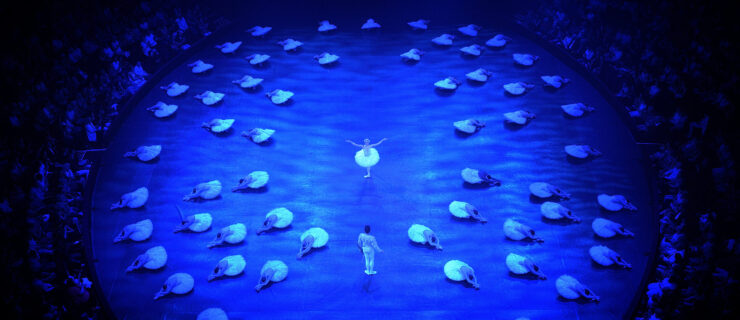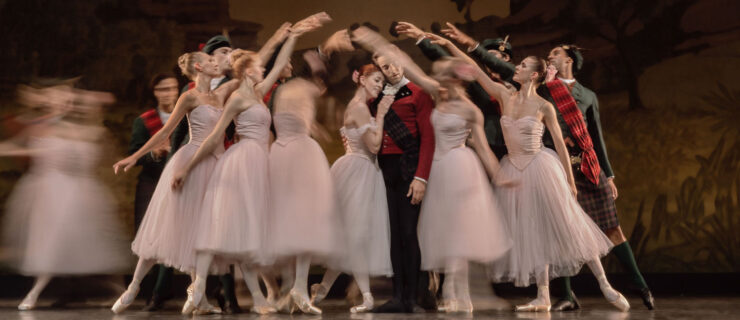Director's Notes: The Little Company That Could
Iain Webb describes himself as “a total bunhead.” To prove it, he takes out his iPhone and brings up a photo of Michel Fokine’s death mask, explaining that it’s part of his personal ballet library in his home. Also in that collection? A photograph of Webb himself hanging a 12-foot Sarasota Ballet banner. “It would have cost $100 to pay someone else to put it up,” he explains, with a chuckle. “I needed that hundred dollars to buy my dancers one and a half pair of pointe shoes.”
Since becoming Sarasota Ballet’s artistic director in 2007, Webb has stretched the resources—and artistry—of the company in some jaw-dropping ways. Out of a modest $4.1 million yearly budget, Sarasota Ballet has presented 53 company premieres and 33 world premieres in just seven seasons. Ticket sales have quadrupled. And the troupe has gained international recognition for its interpretations of Sir Frederick Ashton’s ballets. Yet Webb candidly admits that since he arrived, “We’ve literally almost closed three times.”
Webb, 55, feels at home in the underdog role. As a dancer at The Royal Ballet, he suffered from such bad stage fright that he ended his soloist career early to do character roles instead. (“That way I could hide,” he says.) After retiring from the stage in 1996, he became a rehearsal director for Matthew Bourne, then assistant director for K-Ballet Company in Japan, while also putting together galas and festivals where he presented former Royal Ballet colleagues, like Johan Kobborg. “I liked staying behind the scenes, organizing everything,” he says, “but I was getting old, and it felt like directing was the next level up.” So when Sarasota Ballet was looking for a new leader at the end of 2006, he took the gamble and applied.
The troupe, founded in 1990, had never garnered a lot of attention under its former artistic directors, contemporary choreographer Eddy Toussaint and then Royal Ballet alum Robert de Warren. By the time Webb arrived, it was also riddled with financial problems.
“I remember thinking, ‘This might not last more than a year, so I’d better put together a season that’s going to make me smile,’ ” Webb says. “And also something that’s going to put this company in the history books.” To do that, he convinced Bourne to let Sarasota be the first ballet company to perform his Infernal Galop, and he brought in Hans van Manen to stage Grosse Fuge. He also presented a double bill of Ashton’s Les Patineurs and The Two Pigeons during his second year with the company.
The repertoire over the past seven seasons has been carefully calibrated for the Sarasota audience, which is largely filled with “snowbirds” from the Northeast who have high classical standards set by major companies like American Ballet Theatre and Boston Ballet. Rather than compete, Webb found that by embracing his inner bunhead he could create his own niche: historical one-acts. “I looked at all the companies that were at our same level or the next level up, and they were all doing very similar rep,” Webb says. “If we were going to survive, we had to do something different.”
In particular, Webb gravitated to Ashton’s one-acts, and Sarasota Ballet now has more works by “Sir Fred” than any other American company. “His ballets are so musical, and I love how he always gets the female dancer to look like a woman,” Webb says. “People don’t do these works much anymore, but they need to be seen or else they will be lost.” Both Webb and his wife, former Royal Ballet dancer Margaret Barbieri (who is now Sarasota’s assistant director), were coached by Ashton during their performing careers and bring firsthand knowledge to the work. Some British critics have written that the company’s grasp of Ashton’s style surpasses even The Royal Ballet’s. This May, Sarasota’s four-day Ashton festival will showcase 11 of the choreographer’s ballets, along with films and lecture/discussions. Ticket orders from as far away as Europe were placed months in advance.
Webb has leveraged his high-profile connections throughout his tenure. One of his first steps as director was flying to London to have tea with Lady Deborah MacMillan to ask if he could get a couple of Kenneth’s ballets. Christopher Wheeldon once offered up a piece after Barbieri mentioned Sarasota Ballet’s struggles to the choreographer’s parents one night. And when Sarasota Ballet’s star dancer retired just before a production of Giselle in 2009, Webb got out his address book and was able to announce to the press just four hours later that Alina Cojocaru and Johan Kobborg would be performing instead.
How has he financed this? In the beginning, many of those connections offered their services for limited fees. Webb also used much of his own money at first to cover expenses like physical therapy and costumes. Since then, a handful of donors who believe in his vision have paid off the company’s debts and funded items like last season’s pay raise for the dancers.
The company still lacks the finances for more seasoned dancers’ paychecks, and Webb admits that many of his company members are very green. But he’s found a hungry group (almost all are now his hires) who work to meet the high standards he sets in order to attract big-name choreographers to Sarasota. Webb’s also working on building talent from the ground up: In 2012, Sarasota Ballet launched the Margaret Barbieri Conservatory of Dance, a full-time pre-professional training program designed to be a feeder for the company.
Webb is realistic about his company’s place in the larger dance world: “If I weren’t the director, I would probably think, ‘Well, I don’t know if they should quite try to do that rep.’ ” But he will never put a work onstage that he isn’t proud of. And he refuses to let the company’s modest reputation stop him from trying to create something that will make him smile. It’s in part thanks to that ambition that, earlier this year, he was awarded a 10-year extension of his contract. “We’re never going to be one of the big companies,” he admits, “but we’re going to have something that’s unique.”
At a glance
Sarasota Ballet
Number of dancers: 43
Length of contract: 36 weeks
Starting salary: $350 per week
Performances per year: 7 productions, an average of 32 shows
Website: sarasotaballet.org
Audition Advice
“I look at dancers’ personalities, because you’ve got to live with these people. I can’t have cliques or dancers who watch other dancers’ solos and think, ‘That should be me.’ ”





